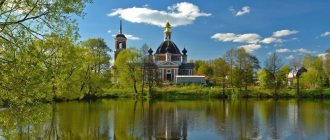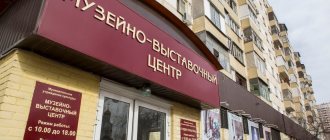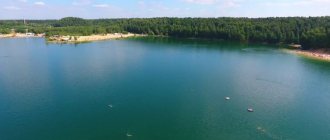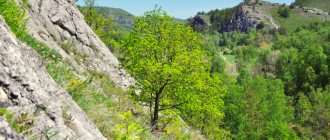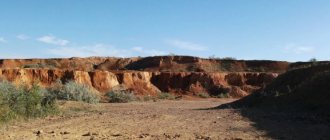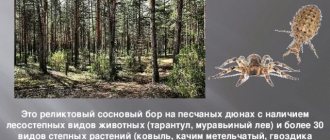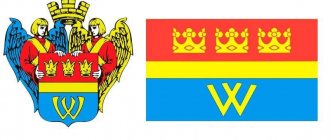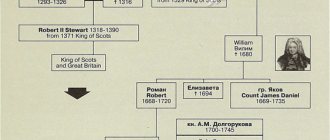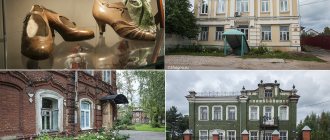Ancient Istra is located 40 kilometers from Moscow. The sights of this city are wooden churches and estates. It will appeal to those who enjoy leisurely walks along quiet streets and inimitable Russian landscapes. According to archaeologists, the first Slavs lived here during the “Early Iron” era, in the 6th – 7th centuries. They erected fortresses and built monasteries. Without a doubt, this land holds many mysteries and has a rich history. Find out more in our material about the city of Istra, where Little Jerusalem and other cultural monuments are located.
New Jerusalem
What you need to see in 1 day in Istra first. The Resurrection Cathedral, the building of which is decorated with a rotunda with a tent, is its main shrine. According to the idea of Patriarch Nikon, this is the only analogue in Rus' of the Church of the Resurrection of Christ in Jerusalem.
The complex was built in the 17th century and now includes six churches. All buildings were built in the same style. An ancient belief says: the monastery has a system of underground passages in which treasures are walled up. Also on the territory of Istra there are many other shrines with a long and interesting history.
Parks, squares, green areas of Istria
Revolution Square is a small square in the very center of Istra. There is also a mandatory attribute of any Russian city - a monument to Lenin.
Behind Lenin is the grave-monument to the hero of the USSR A.P. Bosov. Alexey Petrovich Bosov - commander of a tank company, died in battle on November 18, 1941; his tank crews accounted for 8 (according to other sources - 11) knocked out and destroyed enemy tanks, as well as one aircraft by ramming.
A fountain is being installed in the background.
On the left is the Wall of Memory, on which the names and portraits of 90 Istra front-line soldiers who fell on the battlefields of the Great Patriotic War and died in the post-war period are immortalized.
And right there a monument was erected to a water utility mechanic. The monument was opened in 2014 near the place where the first artesian well was cut 90 years ago.
Across the road from Revolution Square is the administration building of the Istra municipal district against the backdrop of a huge pile of garbage.
The city park opened at the end of 2016. The park is divided into three zones:
At the main entrance there is an orchard area.
Tree seedlings were planted by residents of Istria last year.
The idea is great, but we need to continue to work on implementation: prepare the soil surface, lay a lawn, frame the embankment path. It will be an excellent place for summer picnics; it will be especially cozy on the slope by the river.
When we arrived, there was a lot of garbage in the park, the path began to spread out to the sides, and the ground was trampled down.
Excuse me, what is this?
To the north is a patriotic zone in which monuments to military operations have been erected.
Here is an Il-2 plane taking off, which children love to run up on:
Armored attack aircraft - Il-2, developed by S.V. Ilyushin before the start of the Second World War to destroy ground targets. The peculiarity of this aircraft was a streamlined armored hull, armored glass, a specially designed powerful engine, rapid-firing aircraft cannons and rockets, the crew consisted of only one person who performed the work of both pilot and gunner.
The appearance of the Il-2 on the fronts came as a complete surprise to the enemy. The legendary “flying tank” became “black death” for the invaders and until the end of the war it destroyed enemy personnel and equipment.
Here you can clearly see how the enemy was pushed back from Moscow:
Not far from the legendary Il-2, a completely new stele of military valor was installed in honor of the awarding of the title of city of military glory to the Istra urban district in 2015. “During the Second World War, more than 20 thousand Istrians stood up to defend the freedom and independence of our Motherland, almost half did not return from the war”
The park ends with a children's playground, located on the site of a former amusement park. Playgrounds, slides, a stage - all this is in the children's area.
In front of the main entrance to the park is the House of Culture. The building was built in 1961. The Palace of Culture regularly hosts concerts, theater groups perform, sections, clubs and circles work. The cultural center has several concert halls, cafes and small auditoriums for lectures and seminars.
On the opposite side of Pervomaiskaya Street there are residential buildings. For some reason the first floor and balconies were painted clown yellow, they probably decided it would be more fun.
Behind the park on the steep bank of the Istra River there is a secluded church-chapel of the Ascension of the Lord. This is a remake from 2005, built two hundred meters from the historical site. The historical building of the Church of the Ascension, built at the time when Istra was the village of Safatovo, has long been destroyed. Historians still argue about some events and dates.
The first wooden church, built in the first half of the 17th century, was called Resurrection; about 30-40 years later another wooden church, Voznesenskaya, was built to replace it. After another 100 years (around the 1800s), the small wooden church no longer met the needs of the growing city, so the stone Ascension Church was built to replace it. In 1910 (another 100 years later) the temple was expanded. In 1934, after the October Revolution and the active struggle against religion, the temple was closed, the cross was removed, the bells were thrown down, and the bell tower was dismantled. After the 1941 war, the building was completely damaged and was never restored. The ruins were finally dismantled in the 1960s.
A new small wooden chapel was built on a vacant site and they are even planning to rebuild it into a stone church, but whether this will be done is unknown.
From the hillock there is a wonderful view of the river valley and the New Jerusalem Monastery:
Such interesting landscapes just require that they be put in order and made a place of rest for townspeople and visitors: to cut down bushes, improve old trees, cover the slope and the river bank with a lawn, make several stairs and stone paths.
Around the memorial to the warrior-defenders of the city of Istra, at the turn of Pervomaiskaya Street towards the monastery, there is a small green square of trees. The memorial was erected in 1980 on the mass grave of Soviet soldiers who died during the liberation of Istra in 1941. Memorial plaques list the names of those killed.
And this is the white stone worship cross of Patriarch Nikon. The cross has stood since the 17th century, when the patriarch called this hillock Mount of Olives; here in 1666 the patriarch prayed for the last time before his exile; here stood the coffin of Patriarch Nikon before his burial in 1681. The cross was restored in 2005.
Architectural and Ethnographic Museum of Wooden Architecture
The sights of the Istrinsky district of the Moscow region delight history buffs. This museum is located on Pushkarskaya Street. It was erected in the second half of the 20th century. Historical buildings from nearby cities were brought here:
- Kokorins' estate;
- 18th century chapel;
- a 19th-century windmill;
- Church of the Epiphany and others.
All objects are made of wood and represent masterpieces of Russian architecture.
Noble nests
The proximity to Moscow predetermined the interest of the nobility in the picturesque surroundings of Istra. They were ideal for a country holiday. This is how a whole bunch of luxurious estates appeared on the territory of the district. Alas, not all of them are presented in their original form. But even in this condition, the buildings allow us to get an idea of the tastes and well-being of their owners.
The largest of them is the Ivanovskoye-Kozlovskoye estate. It was built at the beginning of the 18th century for the Gagarin princes. Thanks to the tower with a domed roof, it resembles a medieval castle. From the Yurkino estate on the banks of the Istra River, only the Nativity Church has survived. Among its owners were princes Dolgorukov, Obolensky, Romodanovsky.
The Ognikovo-Pokrovskoye estate was Naryshkina’s estate, then it belonged to Potemkin. Today it houses a fashionable hotel. Tourists can visit the estate church of the Intercession of the Blessed Virgin Mary. The list of noble nests in the Istra region also includes Pokrovskoye - Rubtsovo, Pavlovskaya Sloboda, Troitskoye and Polevshino. In the old days they knew how to choose good places to relax!
Chekhov's places
Istra, Moscow region, is rich in attractions and traveling through it is interesting not only for pilgrims and lovers of Russian architecture. Literature connoisseurs can visit the places where the writer Anton Pavlovich Chekhov lived. The city has an unusual monument to the classic - four old brick pillars that protrude onto the sidewalk next to the House of Culture. A bust of the writer is installed near the House of Culture, and near the drama theater there is his monument.
Pokrovskoye-Rubtsovo Estate
Address: pos. Pokrovskoye-Rubtsovo How to get there: from Rizhsky station to the station. Novoierusalimskaya, then bus number 25
The estate was built in the 17th century by the boyars Nashchokins. It flourished at the end of the 18th century, when the estate was owned by the Golokhvastov nobles. The house was rebuilt in the style of late classicism, and a landscape park was laid out. At this time, Alexander Herzen, who was the owner’s cousin, was here. In 1890, the estate was bought by Savva Morozov. He entrusted the reconstruction of the estate to the architect F. Shekhtel. At this time, many famous people came to the estate: A. Chekhov, V. Kachalov, V. Klyuchevsky.
Currently, a two-story house, an outbuilding, a church, and a park have been preserved. The estate is available for external inspection.
Istra, attractions: what to see in one day
If you are limited in time, then pay attention to the main shrine - this is the Resurrection New Jerusalem Monastery on Sovetskaya, 2. In one day you can visit the main temple, a huge museum complex and learn many interesting facts. And then take a walk around the city center.
From the railway station it is cheaper to take buses No. 32, No. 33 to the “Museum” stop. It’s easier and faster to take a taxi. You will spend only 10 minutes on the road and pay 150 - 200 rubles.
The museum complex is open daily from 10 to 19 hours. If you buy a tour as part of a group, you will be able to get comprehensive information about the complex’s facilities. A ticket to it costs 2000. You can explore the exhibits of the permanent exhibition yourself for 400 rubles. A discount ticket to visit the museum will cost 200 rubles.
Estate Filatovo
Address: Filatovo village How to get there: by bus from Istra station (12 km)
The first owners of the estate were the Pleshcheev boyars, who rebuilt this estate in the 17th century. The estate was sold several times. The last owner of the estate, M. Karpova, built a building for the Zemstvo School here, reconstructed a two-story manor house and an outbuilding. The estate has a large park with an area of 7.5 hectares. The estate is an architectural monument of regional significance. Available for external inspection.
Tesla coil
This is the popular name for the high-voltage test coils built in the forests near Istra by the All-Russian Electrotechnical Institute. Scientists have studied the effects of super-powerful electromagnetic pulses. Local residents say that an anomalous lightning strike 150 meters long was recorded here. Not everyone manages to get to the facility - it is classified as protected. However, some curious tourists manage to make their way to the semi-abandoned site. A landmark for adventure seekers is Zavodskaya Street, 5.
How to get there
There are three ways to get from Moscow to Istra - by car, bus and train. By car it is better to go along the Volokolamsk or Novorizhskoe highway. Istra is connected to the capital by bus routes No. 580 and 372. Buses run from the Myakinino metro station and the Tushino bus station. Travel time is 55-75 minutes. The movement interval is about half an hour.
Electric trains to Istra depart from Rizhsky Station. You should choose directions to Novoierusalimskaya, Rumyantsevo, Shakhovskaya, Volokolamsk. You can take the train on the platforms near the Dmitrovskaya, Tushino, and Voikovskaya metro stations. Travel time from the station is from 80 minutes.
